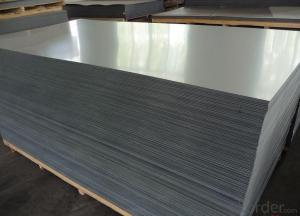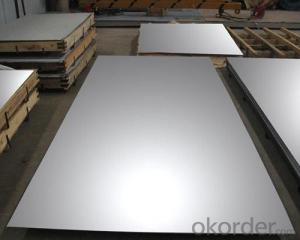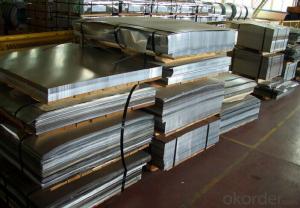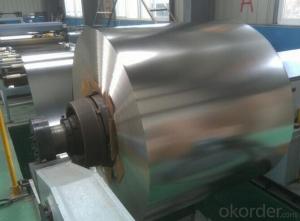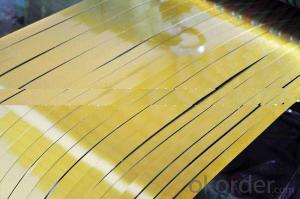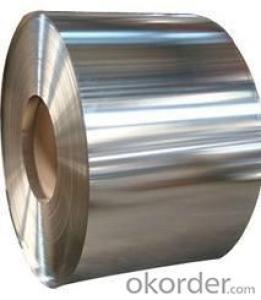Electrolytic Tinplate Sheets for Food Cans Packing
- Loading Port:
- Tianjin
- Payment Terms:
- TT OR LC
- Min Order Qty:
- 25 m.t
- Supply Capability:
- 7000 m.t/month
OKorder Service Pledge
OKorder Financial Service
You Might Also Like
1.Structure of Electrolytic Tinplate Sheets for Food Cans Packing Description
Electrolytic Tin Plate Coils and Sheets for Foods Metal Packaging, is one thin steel sheet with a coating of tin applied by electrolytic deposition. Tinplate made by this process is essentially a sandwich in which the central core is strip steel. This core is cleaned in a pickling solution and then fed through tanks containing electrolyte, where tin is deposited on both sides. As the strip passes between high-frequency electric induction coils, it is heated so that the tin coating melts and flows to form a lustrous coat.
2.Main Features of the Electrolytic Tinplate Sheets for Food Cans Packing
Appearance – Electrolytic Tin Plate is characterized by its beautiful metallic luster. Products with various kinds of surface roughness are produced by selecting the surface finish of the substrate steel sheet.
Paintability and printability – Electrolytic Tin Plates have excellent paintability and printability. Printing is beautifully finished using various lacquers and inks.
Formability and strength – Electrolytic Tin Plates have got very good formability and strength. By selecting a proper temper grade, appropriate formability is obtained for different applications as well as the required strength after forming.
Corrosion resistance – Tinplate has got good corrosion resistance. By selecting a proper coating weight, appropriate corrosion resistance is obtained against container contents. Coated items should meet 24 hour 5 % salt spray requirement.
Solderability and weldability – Electrolytic Tin Plates can be joined both by soldering or welding. These properties of tinplate are used for making various types of cans.
Hygienic – Tin coating provides good and non toxic barrier properties to protect food products from impurities, bacteria, moisture, light and odours.
Safe – Tinplate being low weight and high strength makes food cans easy to ship and transport.
Eco friendly – Tinplate offers 100 % recyclability.
Tin is not good for low temperature applications since it changes structure and loses adhesion when exposed to temperatures below – 40 deg C.
3.Electrolytic Tinplate Sheets for Food Cans Packing Images

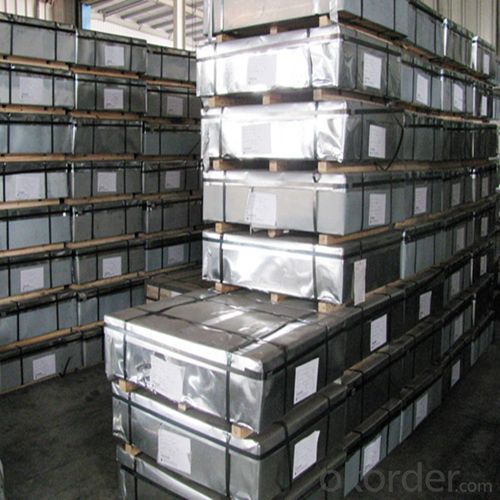
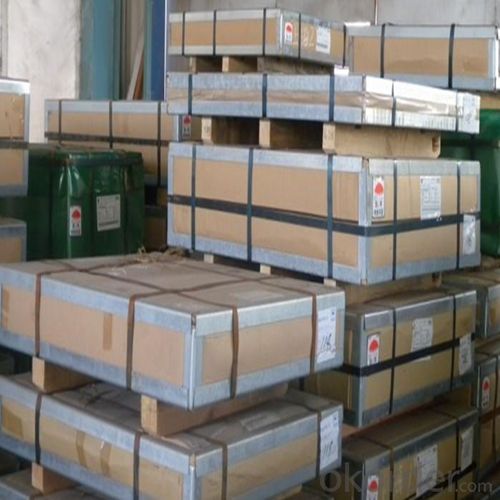
4.Electrolytic Tinplate Sheets for Food Cans Packing Specification
Standard | ISO 11949 -1995, GB/T2520-2000,JIS G3303,ASTM A623, BS EN 10202
|
Material | MR,SPCC |
Thickness | 0.15mm - 0.50mm |
Width | 600mm -1150mm |
Temper | T1-T5 |
Annealing | BA & CA |
Coil Inner Diameter | 508mm |
Weight | 6-10 tons/coil 1~1.7 tons/sheets bundle |
Passivation | 311 |
Oil | DOS |
Surface | Finish,bright,stone,matte,silver |
5.FAQ of Electrolytic Tinplate Sheets for Food Cans Packing
- How are the Electrolytic Tin Plates specified?
The Electrolytic Tin Plates are specified as per the steel base, extent of tempering, the coating weight, annealing method and the surface finish.
- How many types there are for base steels?
The base steels are of three types: Type MR, L, D
- Q:What are the main applications of tinplate in the gardening industry?
- Tinplate is commonly used in the gardening industry for various applications such as plant pots, seed trays, watering cans, and garden tools. The use of tinplate ensures durability, corrosion resistance, and ease of maintenance, making it an ideal choice for these gardening essentials. Additionally, tinplate can also be utilized for packaging purposes, such as cans for storing fertilizers, pesticides, and other gardening products.
- Q:Can tinplate be used for roofing and construction?
- Yes, tinplate can be used for roofing and construction. Tinplate is a type of steel coated with a thin layer of tin, which provides corrosion resistance and durability. It is commonly used in roofing and construction applications due to its strength, aesthetic appeal, and ability to withstand harsh weather conditions.
- Q:What are the different types of tinplate finishes available?
- There are primarily three types of tinplate finishes available: bright, stone, and matte. Bright tinplate has a shiny and reflective surface, stone tinplate has a textured and grainy appearance, and matte tinplate has a smooth and non-reflective finish. These different finishes offer various aesthetic options for packaging and can be chosen based on the desired look and feel of the final product.
- Q:Can tinplate be used for packaging of flammable liquids?
- No, tinplate is not suitable for packaging flammable liquids as it can easily react with the contents and potentially cause a fire or explosion.
- Q:How does tinplate packaging contribute to product tamper resistance?
- Tinplate packaging contributes to product tamper resistance by providing a strong and durable barrier that is difficult to manipulate or breach without leaving visible signs of tampering. Its sturdy construction and sealed nature make it harder for unauthorized individuals to access the product, ensuring its integrity and safety.
- Q:How does tinplate contribute to food safety?
- Tinplate contributes to food safety as it acts as a protective barrier between the food and the metal surface, preventing any interaction or contamination. Additionally, tinplate is resistant to corrosion and can withstand high temperatures, ensuring the integrity of the packaging and preventing any potential bacterial growth or spoilage.
- Q:How does tinplate contribute to the overall tamper-evident packaging?
- Tinplate contributes to tamper-evident packaging by providing a durable and secure material that is difficult to tamper with. Its strength and rigidity make it resistant to punctures or tears, ensuring that the packaging remains intact until it reaches the consumer. Additionally, tinplate can be sealed tightly, preventing unauthorized access and providing a visible sign of tampering if the seal is broken. Overall, tinplate enhances the safety and integrity of tamper-evident packaging, giving consumers confidence in the quality and authenticity of the product.
- Q:How is tinplate coated for electrical enclosures?
- Tinplate is commonly coated for electrical enclosures through a process called electroplating, which involves immersing the tinplate into an electrolyte solution and applying an electric current. This causes tin ions to be deposited onto the surface of the tinplate, creating a thin and protective layer of tin coating.
- Q:What are the safety considerations when handling tinplate?
- When handling tinplate, it is essential to consider several safety measures. First, tinplate can have sharp edges, so wearing gloves and using appropriate tools is important to avoid cuts or injuries. Secondly, tinplate is often coated with various substances, such as lacquer or resin, which may contain harmful chemicals. Therefore, it is crucial to handle tinplate in well-ventilated areas and wear protective equipment like goggles and masks to minimize exposure. Additionally, tinplate can be heavy and bulky, so proper lifting techniques should be employed to prevent strains or back injuries. Lastly, storing tinplate in a dry and clean area can help prevent corrosion and maintain its structural integrity.
- Q:How to quickly distinguish tinplate and ordinary substrate iron?
- Tinplate is the substrate, iron tin plating, tin bright, the substrate is dark, the substrate for a few days rust, and the two put together, the difference is great.
1. Manufacturer Overview |
|
|---|---|
| Location | |
| Year Established | |
| Annual Output Value | |
| Main Markets | |
| Company Certifications | |
2. Manufacturer Certificates |
|
|---|---|
| a) Certification Name | |
| Range | |
| Reference | |
| Validity Period | |
3. Manufacturer Capability |
|
|---|---|
| a)Trade Capacity | |
| Nearest Port | |
| Export Percentage | |
| No.of Employees in Trade Department | |
| Language Spoken: | |
| b)Factory Information | |
| Factory Size: | |
| No. of Production Lines | |
| Contract Manufacturing | |
| Product Price Range | |
Send your message to us
Electrolytic Tinplate Sheets for Food Cans Packing
- Loading Port:
- Tianjin
- Payment Terms:
- TT OR LC
- Min Order Qty:
- 25 m.t
- Supply Capability:
- 7000 m.t/month
OKorder Service Pledge
OKorder Financial Service
Similar products
New products
Hot products
Hot Searches
Related keywords
